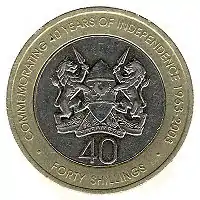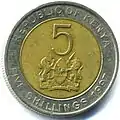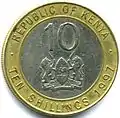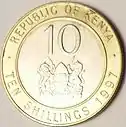Kenyan shilling
The shilling (Swahili: shilingi; sign: KSh; code: KES) is the currency of Kenya. It is divided into 100 cents).
| Kenyan shilling | |||||
|---|---|---|---|---|---|
| Shillingi ya Kenya (Swahili) | |||||
| |||||
| ISO 4217 | |||||
| Code | KES | ||||
| Denominations | |||||
| Subunit | |||||
| 1/100 | cent | ||||
| Symbol | KSh, /=, /-, K | ||||
| Banknotes | |||||
| Freq. used | 50, 100, 200, 500 and 1000 shillings | ||||
| Rarely used | 5, 10, 20 shillings | ||||
| Coins | |||||
| Freq. used | 1, 5, 10 , 20 shillings | ||||
| Rarely used | 50-cents | ||||
| Demographics | |||||
| User(s) | |||||
| Issuance | |||||
| Central bank | Central Bank of Kenya | ||||
| Website | www | ||||
| Valuation | |||||
| Inflation | 5.1% | ||||
| Source | Kenya National Bureau of Statistics, as of June 2010. | ||||
Exchange rate
The exchange rate of the Kenyan shilling slumped dramatically in mid-2011, from about 83 shillings per US dollar to about 100 shillings per US dollar at late 2011 and to 105 shillings in September 2015. The Central Bank of Kenya shifted its target to tighten liquidity, including increasing interest rate and money market operations. But expected inflows due to tea export drove up the exchange rate to about 84 shillings per US dollar on 31 January 2012.[1]
| Current KES exchange rates | |
|---|---|
| From Google Finance: | AUD CAD CHF EUR GBP HKD JPY USD |
| From Yahoo! Finance: | AUD CAD CHF EUR GBP HKD JPY USD |
| From XE.com: | AUD CAD CHF EUR GBP HKD JPY USD |
| From OANDA: | AUD CAD CHF EUR GBP HKD JPY USD |
| From fxtop.com: | AUD CAD CHF EUR GBP HKD JPY USD |
1994 10 shilling
The Kenyan shilling replaced the East African shilling in 1966 at par.
Coins
| 10 Kenyan cents (1980). | |
|---|---|
.jpg.webp) | |
| Obverse: Bust of Daniel arap Moi with lettering "PRESIDENT OF REPUBLIC OF KENYA DANIEL TOROITICH ARAP MOI". | Reverse: Face-value, year, Coat of arms of Kenya and country name. |

The first coins were issued in 1966 in denominations of 5, 10, 25 and 50 cents, and 1 and 2 shillings; 25-cent coins were not minted after 1969 (except in the 1973 set); 2-shilling coins were last minted in 1971 (except in the 1973 set). In 1973 and 1985, 5-shillings coins were introduced, followed by 10-shillings in 1994 and 20-shillings in 1998.
Between 1967 and 1978, the portrait of Jomo Kenyatta, the first president of Kenya, originally appeared on the obverse of all of independent Kenya's coins. In 1980, a portrait of Daniel arap Moi replaced Kenyatta until 2005, when the central bank introduced a new coin series that restored the portrait of Kenyatta. The coins are 50 cents and 1 shilling in stainless steel and bi-metallic coins of 5, 10 and 20.
 5 Shillings Coin - obverse
5 Shillings Coin - obverse 5 Shillings Coin - reverse
5 Shillings Coin - reverse 10 Shillings Coin
10 Shillings Coin 20 Shillings Coin
20 Shillings Coin
A bi-metallic 40-shilling coin with the portrait of then-President Mwai Kibaki was issued in 2003 to commemorate the fortieth anniversary of independence (1963–2003). New coins with the image of Kenyatta were issued in 2005. In 2010, Section 231(4) of the 2010 Constitution of Kenya stated "Notes and coins issued by the Central Bank of Kenya may bear images that depict or symbolise Kenya or an aspect of Kenya but may not bear the portrait of any individual." New banknotes and coins are scheduled to be released by 2018 to meet up with this new law.[2] A new series of coins was issued on 11 December 2018, in denominations of 1-, 5-, 10 and 20 shillings. All of the coins depict the national Coat of arms of Kenya on the obverse and images of Africa's recognizable animals on the reverse.[3] The new series of coins is designed to be more recognizable for visually impaired people.[4]
| Coins of the Kenyan shilling (2018 issues) | |||||||||
|---|---|---|---|---|---|---|---|---|---|
| Image | Value | Technical parameters | Description | Date of first minting | |||||
| Diameter | Thickness | Mass | Composition | Edge | Obverse | Reverse | |||
| 1 shilling/shilingi | 23.9 mm | 5.5 grams | Nickel-plated steel | Segmented (Plain and Reeded sections) | Coat of arms of Kenya; text "Republic of Kenya" in English and Swahili | Giraffe; denomination in English and Swahili | 2018 | ||
| 5 shillings/shilingi | 19.5 mm | 3.75 grams | Bi-metallic coin (Brass-plated steel center plug with a Nickel-plated steel outer ring) | Reeded | Coat of arms of Kenya; text "Republic of Kenya" in English and Swahili | Rhinoceros; denomination in English and Swahili | 2018 | ||
| 10 shillings/shilingi | 23 mm | 5 grams | Bi-metallic coin (Nickel-plated steel center plug with a Brass-plated steel outer ring) | Reeded | Coat of arms of Kenya; text "Republic of Kenya" in English and Swahili | Lion; denomination in English and Swahili | 2018 | ||
| 20 shillings/shilingi | 26 mm | 9 grams | Bi-metallic coin (Brass-plated steel center plug with a Nickel-plated steel outer ring) | Segmented (Plain and Reeded sections) | Coat of arms of Kenya; text "Republic of Kenya" in English and Swahili | Elephant; denomination in English and Swahili | 2018 | ||
Banknotes
On 14 September 1966, the Kenyan shilling replaced the East African shilling at par, although the latter was not demonetised until 1969. The Central Bank of Kenya issued notes in denominations of 5, 10, 20, 50 and 100 shillings. All of the notes feature a portrait of Kenya's first prime minister and president, Jomo Kenyatta, on the front and diverse economic activities on the back.[5]
5 shillings notes were replaced by coins in 1985, with the same happening to 10 and 20 shillings in 1994 and 1998. In 1986, 200 shillings notes were introduced, followed by 500 shillings in 1988 and 1000 shillings in 1994.
As with the coins, Kenyatta appeared on the banknotes issued until 1978, with Daniel arap Moi's portrait replacing him in 1980. In 2003, after Mwai Kibaki replaced Moi as president, 5, 10, and 20 shillings notes from the 1978 series with Kenyatta's picture that had been in storage were issued, and circulated for a time. A new series of notes was then introduced on which Kenyatta reappeared in denominations of 50, 100, 200, 500 and 1000 shillings. The issue of the 200 shillings banknote dated 12 December 2003 commemorates the "40 years of Independence 1963–2003". The banknotes are printed in Nairobi by security printer De La Rue.
On 31 May 2019, the Central Bank of Kenya issued a new family of banknotes without the portraits of known Kenyan individuals, as mandated by the Constitution of Kenya of 2010. At the same time, the Central Bank of Kenya has withdrawn all previous versions of the 1,000 shillings banknote. These remained legal tender until 1 October 2019. All of the banknotes for this series share a common design of the Kenyatta International Convention Centre on the front side of the notes, and the back side of the notes feature images showcasing the richness of the people and nature of Kenya: "Green Energy" (50 shillings), "Agriculture" (100 shillings), "Social Services" (200 shillings), "Tourism" (500 shillings) and "Governance" (1,000 shillings). All five denominations also embody each of the big five animals of Africa: the buffalo (50 shillings), the leopard (100 shillings), rhinoceros (200 shillings), the lion (500 shillings) and the elephant (1,000 shillings).[6]
| Banknotes of the Kenyan shilling (1996 "Arap Moi" issue) | ||||
|---|---|---|---|---|
| Denomination | Obverse | Reverse | Watermark | |
| 20 shillings (Shilingi Ishirini) | President Daniel Toroitich arap Moi; Coat of arms of Kenya | Baton; Moi International sports complex, Nairobi, jogger | Lion's head | |
| 50 shillings (Shilingi Hamsini) | President Daniel Toroitich arap Moi; Coat of arms of Kenya | Caravan; Elephant tusks monument in Moi Avenua (formerly Kilindini Road), Mombasa | Lion's head | |
| 100 shillings (Shilingi Mia Moja) | President Daniel Toroitich arap Moi; Coat of arms of Kenya | Monument to the 25th anniversary of independence, Nairobi | Lion's head | |
| 200 shillings (Shilingi Mia Mbili) | President Daniel Toroitich arap Moi; Coat of arms of Kenya | Unity monument, Nairobi | Lion's head | |
| 500 shillings (Shilingi Mia Tano) | President Daniel Toroitich arap Moi; Coat of arms of Kenya | Parliament building, Nairobi | Lion's head | |
| 1000 shillings (Shilingi Elfu Moja) | President Daniel Toroitich arap Moi; Coat of arms of Kenya | Elephants | Lion's head | |
| Banknotes of the Kenyan shilling (2004 "Jomo Kenyatta" issue (to be withdrawn from circulation)) | ||||
|---|---|---|---|---|
| Denomination | Obverse | Reverse | Watermark | |
| 50 shillings (Shilingi Hamsini) | President Jomo Kenyatta; Coat of arms of Kenya | Caravan; Elephant tusks monument in Moi Avenua (formerly Kilindini Road), Mombasa | Lion's head and electrotype 50 | |
| 100 shillings (Shilingi Mia Moja) | President Jomo Kenyatta; Coat of arms of Kenya | Kenyatta statue; tower | Lion's head and electrotype 100 | |
| 200 shillings (Shilingi Mia Mbili) | President Jomo Kenyatta; Coat of arms of Kenya | Cotton harvest | Lion's head and electrotype 200 | |
| 500 shillings (Shilingi Mia Tano) | President Jomo Kenyatta; Coat of arms of Kenya | Parliament building, Nairobi | Lion's head and electrotype 500 | |
| 1000 shillings (Shilingi Elfu Moja) | President Jomo Kenyatta; Coat of arms of Kenya | Elephants | Lion's head and electrotype 1000 | |
| Banknotes of the Kenyan shilling (2019 issue (current issue)) | |||||
|---|---|---|---|---|---|
| Image | Denomination | Main Colour | Obverse | Reverse | Watermark |
| 50 shillings (Shilingi Hamsini) | Red | Coat of arms of Kenya; Statue of President Jomo Kenyatta; Kenyatta International Convention Centre; Buffalo | "Green Energy" (Wind Power, geothermal power, solar power) | Lion's head and electrotype 50 | |
| 100 shillings (Shilingi Mia Moja) | Violet | Coat of arms of Kenya; Statue of President Jomo Kenyatta; Kenyatta International Convention Centre; Leopard | "Agriculture" (Cereal, agriculture, livestock) | Lion's head and electrotype 100 | |
| 200 shillings (Shilingi Mia Mbili) | Blue | Coat of arms of Kenya; Statue of President Jomo Kenyatta; Kenyatta International Convention Centre; Rhinoceros | "Social Services" (Health services, Education, sports) | Lion's head and electrotype 200 | |
| 500 shillings (Shilingi Mia Tano) | Green | Coat of arms of Kenya; Statue of President Jomo Kenyatta; Kenyatta International Convention Centre; Lion | "Tourism" (Wildlife; Lion) | Lion's head and electrotype 500 | |
 |
1000 shillings (Shilingi Elfu Moja) | Brown | Coat of arms of Kenya; Statue of President Jomo Kenyatta; Kenyatta International Convention Centre; Elephant | "Governance" (Parliament building, Nairobi) | Lion's head and electrotype 1000 |
Symbol
The Kenyan Shilling has been used since its inception without any symbolic graphic representation. In 2013 a concept symbol was designed by a freelance artist. It gained quite a lot of positive with the Kenyan public praising the idea of finally having and owning their own signature symbol for the local currency, The Kenya Shilling, which has been in existence since 1966 when it replaced the East African Shilling.

The proposed sign or symbol uses the uppercase letter 'K' representing Kenya, and is combined with two parallel lines to represent the "=" symbol. Arithmetically, the equality sign is a function that shows balanced relationships between items of the same value - a relationship that forms the basis of money as a medium of exchange. This equivalence "certifies" the stability of the Shilling.
See also
References
- "Archived copy". Archived from the original on 10 April 2020. Retrieved 14 January 2017.CS1 maint: archived copy as title (link)
- The Constitution of Kenya of 2010; Section 231(4) on the Central Bank of Kenya World Intellectual Property Organization (www.wipo.int). Retrieved on 2013-09-27.
- Kenya: New circulation coin series introduced by president Coin Update (news.coinupdate.com). 27 December 2018. Retrieved on 2018-12-28.
- "Kenya makes coins accessible for the visually impaired". 11 May 2019.
- Linzmayer, Owen (2012). "Kenya". The Banknote Book. San Francisco, CA: www.BanknoteNews.com.
- "Central Bank unveils new generation banknotes to curb fraud". Capital News Kenya. 1 June 2019.
External links
- The banknotes of Kenya (in English and German)
- Benstride
| Preceded by: East African shilling Reason: currency independence Ratio: at par Note: independent shilling introduced in 1966, but EA shilling not demonetised until 1969 |
Currency of Kenya 1966 – |
Succeeded by: Current |


.svg.png.webp)